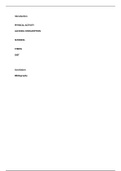Introduction
PHYSICAL ACTIVITY
ALCOHOL CONSUMPTION
SMOKING
STRESS
DIET
Conclusion
Bibliography
,Introduction
In this assignment I will describe the lifestyle factors that can have affect on an individual’s health and lifestyle
and explain how these have either have a positive effect on health and fitness, using evidence and research to
do this. I will describe the benefits of physical activity; recommendations for alcohol consumption and the
health risks of excessive drinking; the health risks of smoking; the health risks of high stress levels and the
health risks of an unhealthy diet. I will then explain these factors and their effects in more detail using research
and examples.
The lifestyle factors that have an effect on health:
Physical Activity
What is physical activity?
Physical activity is regarded as any body movement that places a demand on your muscles and requires more
energy than resting. Examples of physical include but are in no way limited to: Walking, running, dancing,
swimming, yoga, and gardening. ‘According to the Department of Health and Human Services' 2008 Americans
external physical activity generally refers to movement that enhances health.’(nhlbi.nih.gov.2019)
Exercise is often thought to be the same as ‘physical activity’, but it is instead considered to be a ‘type’ of
physical activity as it has structure and is planned. Therefore, examples of exercise include but are not limited
to: Lifting weights, participating in a fitness class, and playing on a sports team.
Recommendations and guidelines for physical activity
Guidelines for adults aged 19 to 64
To stay healthy and to be able to gain the benefits from physical activity, it is recommended by the nhs that
adults aged 19 to 64 should try to do the following:
at least 150 minutes of moderate aerobic activity such as cycling or brisk walking every week and
strength exercises on 2 or more days a week that work all the major muscles (legs, hips, back,
abdomen, chest, shoulders and arms)
Or:
75 minutes of vigorous aerobic activity such as running or a game of singles tennis every week and
strength exercises on 2 or more days a week that work all the major muscles (legs, hips, back,
abdomen, chest, shoulders and arms)
Or:
, a mix of moderate and vigorous aerobic activity every week – for example, 2 x 30-minute runs plus 30
minutes of brisk walking equates to 150 minutes of moderate aerobic activity and
strength exercises on 2 or more days a week that work all the major muscles (legs, hips, back,
abdomen, chest, shoulders and arms)
A good rule is that 1 minute of vigorous activity provides the same health benefits as 2 minutes of moderate
activity. One way in which someone can do the recommended 150 minutes of weekly physical activity is to do
30 minutes on 5 days every week. (nhs.2019)
Benefits of physical activity
Physical activity can improve an individual’s overall health and has been proven to reduce the risk of
developing several diseases like type 2 diabetes, cardiovascular disease and cancer. Taking part in physical
activity and exercise can have immediate and long-term health benefits. Most significantly, regular activity can
improve someone’s overall quality of life. An individual only needs to take part in a minimum of 30 minutes’
worth of physical activity a day in order to reap these benefits.
WEIGHT
Physical activity enables someone to maintain a healthy weight by using excess calories that would otherwise
be stored as fat. This is because the majority of foods that people consume contain calories, and everything
that we do requires the use of calories in the form of energy, this includes sleeping, breathing, and digesting
food. Therefore, by balancing the calories that you consume (take in) with the calories you expend through
physical activity; will enable an individual to both reach and maintain a healthy weight.
HEART AND LUNG FUNCTION
Taking part in physical activity can strengthens an individual’s heart and improve their lung function. This is the
is because by taking part in regular moderate and vigorous intensity physical activity which strengthens your
heart muscle, you are improving your heart's ability to pump blood to the lungs and around the body. As a
result, more blood is able to flow to your muscles and the oxygen levels in the blood rise. The tiny blood
vessels in your body called capillaries also widen which enables them to deliver more oxygen to the body and
carry away waste products.
REDUCTION IN DISEASE RISK FACTORS
“Inactive people are more likely to develop CHD than people who are physically active. Studies suggest that
inactivity is a major risk factor for CHD, just like high blood pressure, high blood cholesterol, and smoking.”
(nhlbi.nih.gov.2019)
Taking part in physical activity reduces coronary heart disease risk factors. When participated in regularly and
consistently, moderate to vigorous intensity aerobic physical activity can lower an individual’s risk of
developing CHD. CHD is a condition which is caused when a waxy substance called plaque builds up inside the
coronary arteries (the arteries that are responsible for supplying the heart muscle with oxygen-rich blood).
This plaque constricts the arteries and as a result reduces the blood that is able to flow to the heart muscle.
Eventually, an area of plaque can rupture which results in a blood clot forming on the surface of the plaque. If





